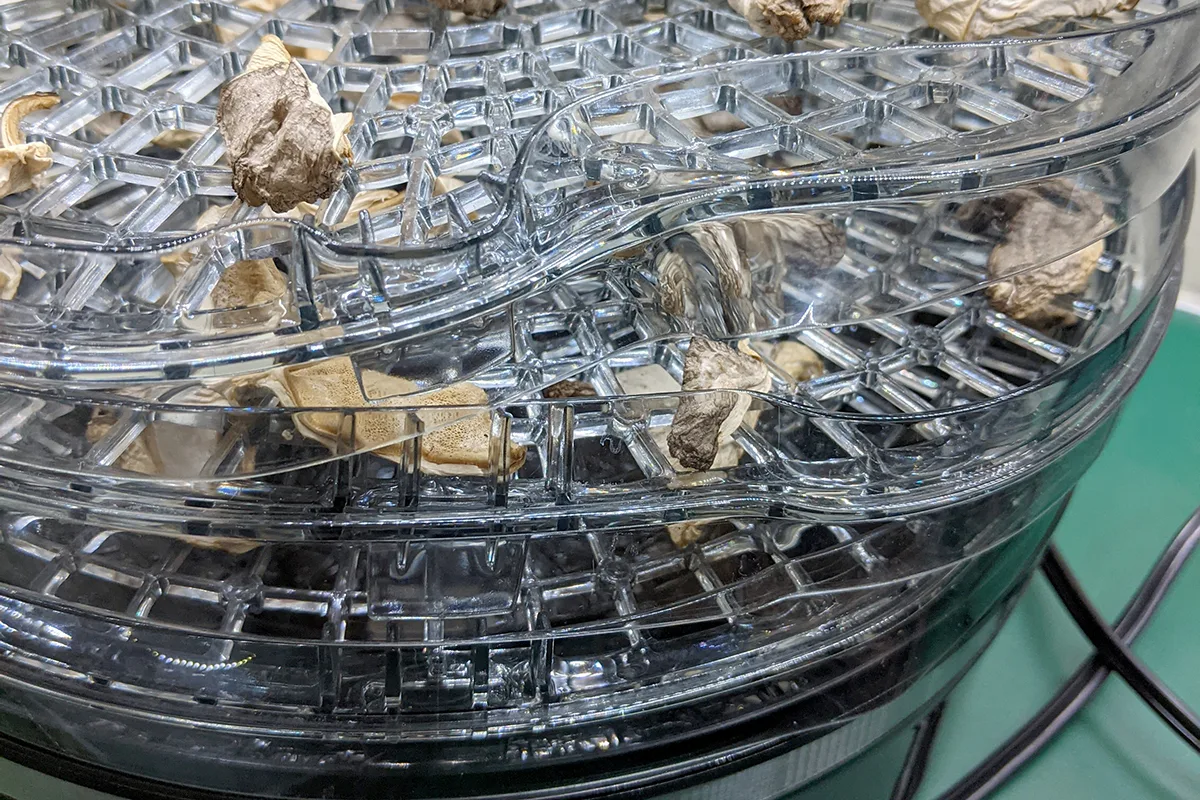
Among my friends, I’m known as a dab hand in the kitchen and garden. However, my family knows better. They see all the kerfuffles, gardening-endeavors-gone-wrong, terrible meals, and dead houseplants it’s taken for me to become the domestic goddess everyone else mistakes me for.
Much of my knowledge comes at the cost of learning what not to do before figuring out that amazing thing that works every time. While this stinks for me, it’s great for you – I fail, so you don’t have to.
So, when it came time to purchase my first food dehydrator, I failed miserably. Of course.
Read on so you don’t make the same mistake.
Why Should You Buy a Food Dehydrator in the First Place?
Gardening and foraging generally leave you with more food than you can eat before it goes bad. If you do either, you learn pretty quickly how to preserve your bounty. Because there’s nothing worse than putting in the hard work of growing or finding food and then watching it go bad on your counter.
Okay, that’s great, Tracey, but why dehydrate stuff in the first place? Isn’t freezing it or canning it better?
Yes.
And no.
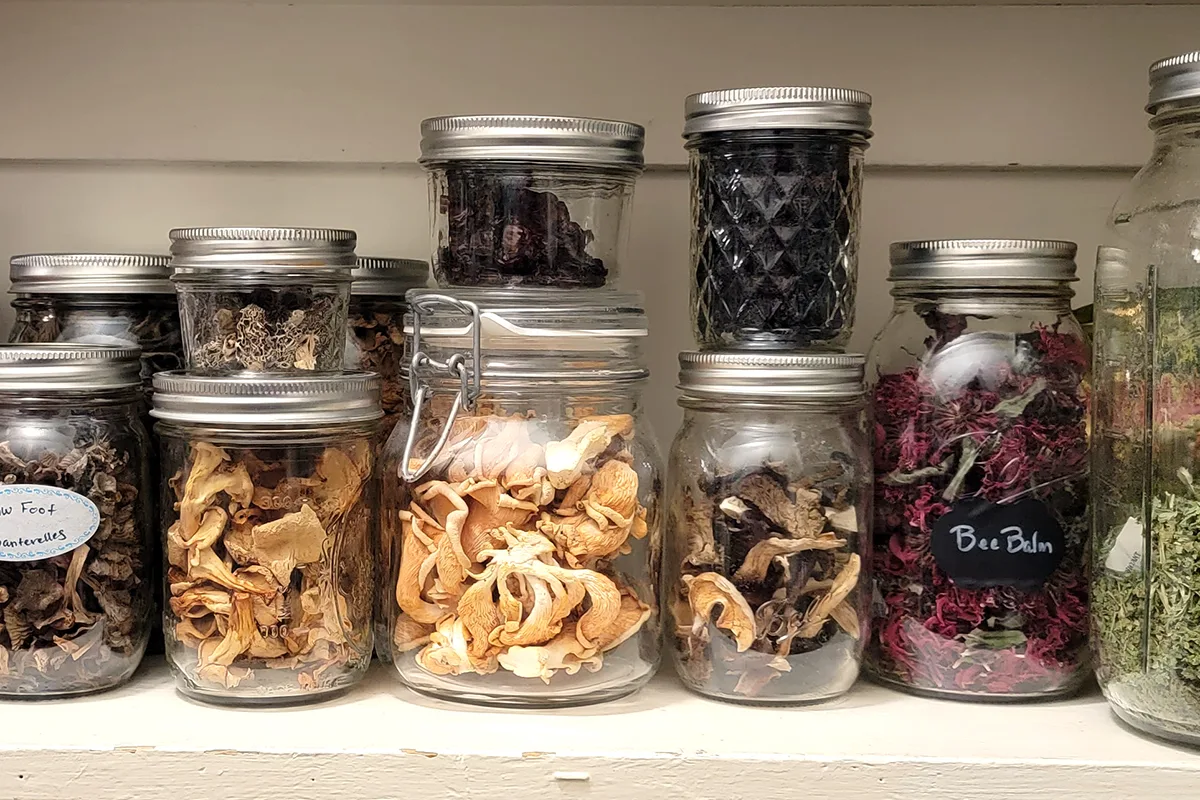
A Backup Plan
Whenever you decide to preserve food, using more than one method is the way to go. If one method fails, for instance, the deep freezer you keep in the garage dies, you will presumably still have canned and dehydrated food to supplement your losses.
Different Preservation Means Different Food Experiences
Food behaves differently depending on how it’s preserved, especially with our limited tools at home. Take mushrooms, for example. In theory, yes, you can freeze them, but once they’re thawed…yeah, I’m a huge mushroom fan, and even I don’t want to eat that slimy mush. However, dehydrated mushrooms that have been reconstituted properly are nearly as good as fresh.
What you plan on doing with your preserved food often determines the method of preserving it.
Dehydrated Food is Efficient
Dehydrating food for storage is a great choice if you’re short on space or want food that will last. Once the water is removed, it takes up much less space than, say, canned or frozen food. Dehydrated foods have a much longer shelf life than other methods of food preservation. And once it’s dehydrated, no further energy is needed to keep it fresh.
I know most of you are thinking, “Okay, so use your oven to dehydrate things.”
Your oven is a great place to start. But you soon learn that an oven has its drawbacks, mainly temperature control. Most ovens can’t be set lower than 150-170F, and that’s problematic when dehydrating.
The higher heat from cooking causes chemical reactions that change the color and flavor of food – think of how much better browned meat tastes or how much sweeter roasted veggies are because of the caramelization of their natural sugars.
When dehydrating foods, we simply want to reduce the water content, not cook them, so lower temperatures are called for.
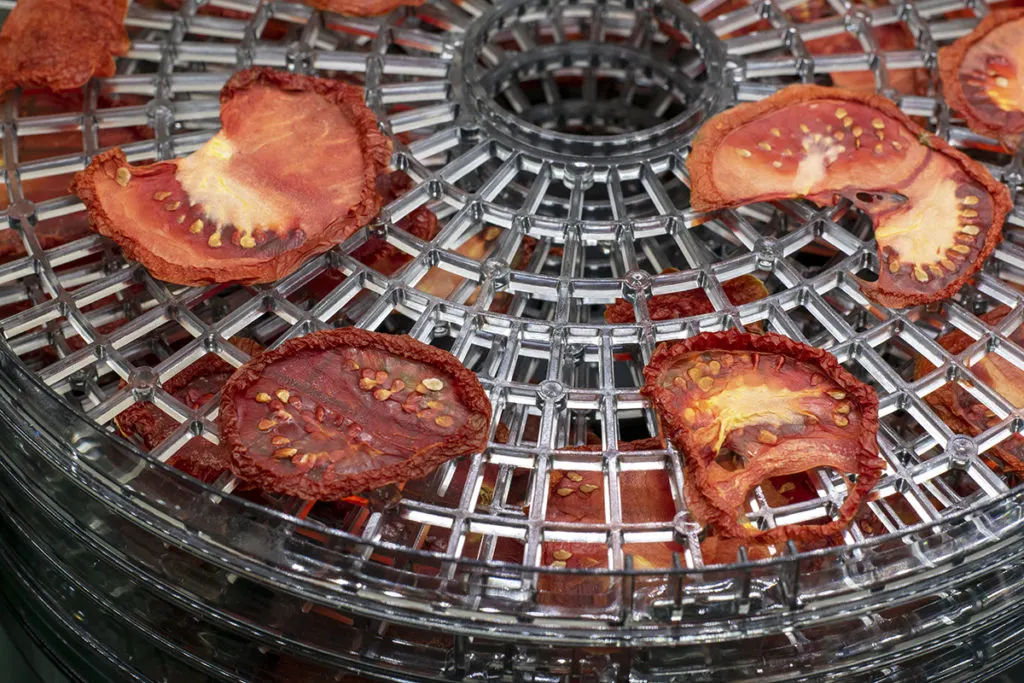
Other factors that make an oven less-than-ideal is the fact that you’re tying up a major appliance for hours on end. It can make preparing meals a pain if you’re waiting on that batch of apple slices that need eight hours to dry. And depending on your model, your oven may not have an internal fan to circulate air, which helps in the dehydration process.
Everyone Loves a Trainwreck
Since I know this is why most of you clicked, yes, I bought a crappy food dehydrator on Amazon.
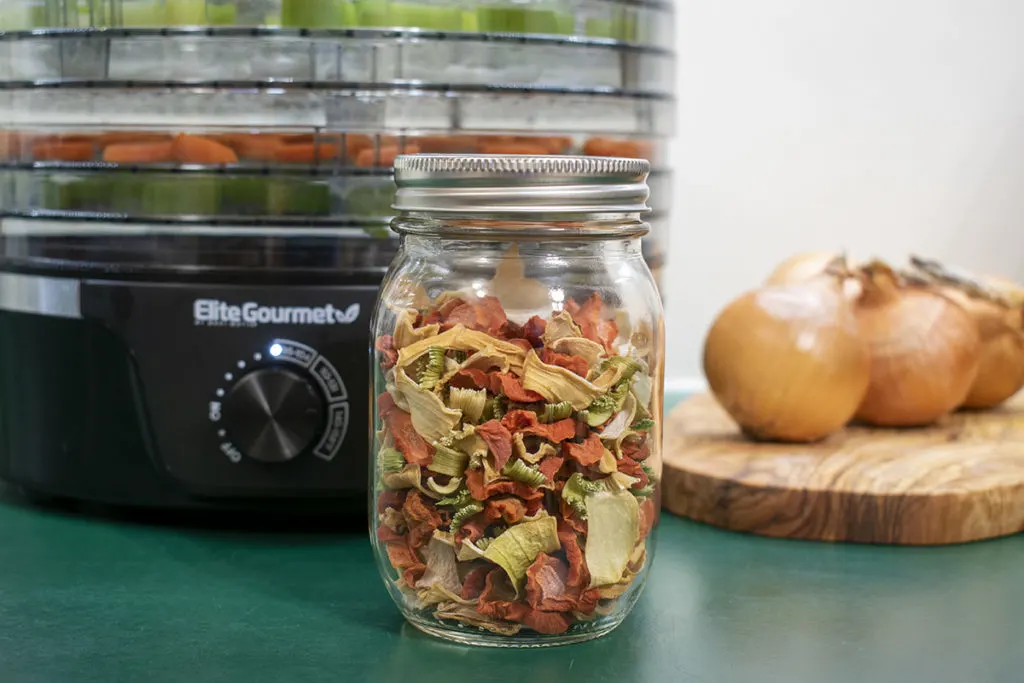
And got exactly what I paid for.
Two months after buying my dehydrator, I spent a Saturday drying some beautiful maitake mushroom I had foraged the previous day. I felt funny all afternoon like I had mild food poisoning. My stomach was queasy, and I had a headache. I couldn’t figure out why I felt so bad and chalked it up to a night of poor sleep. (Yay, middle age!)
That is until I went to swap the topmost tray with the bottom one and noticed my dehydrator had gone all surrealist on me.
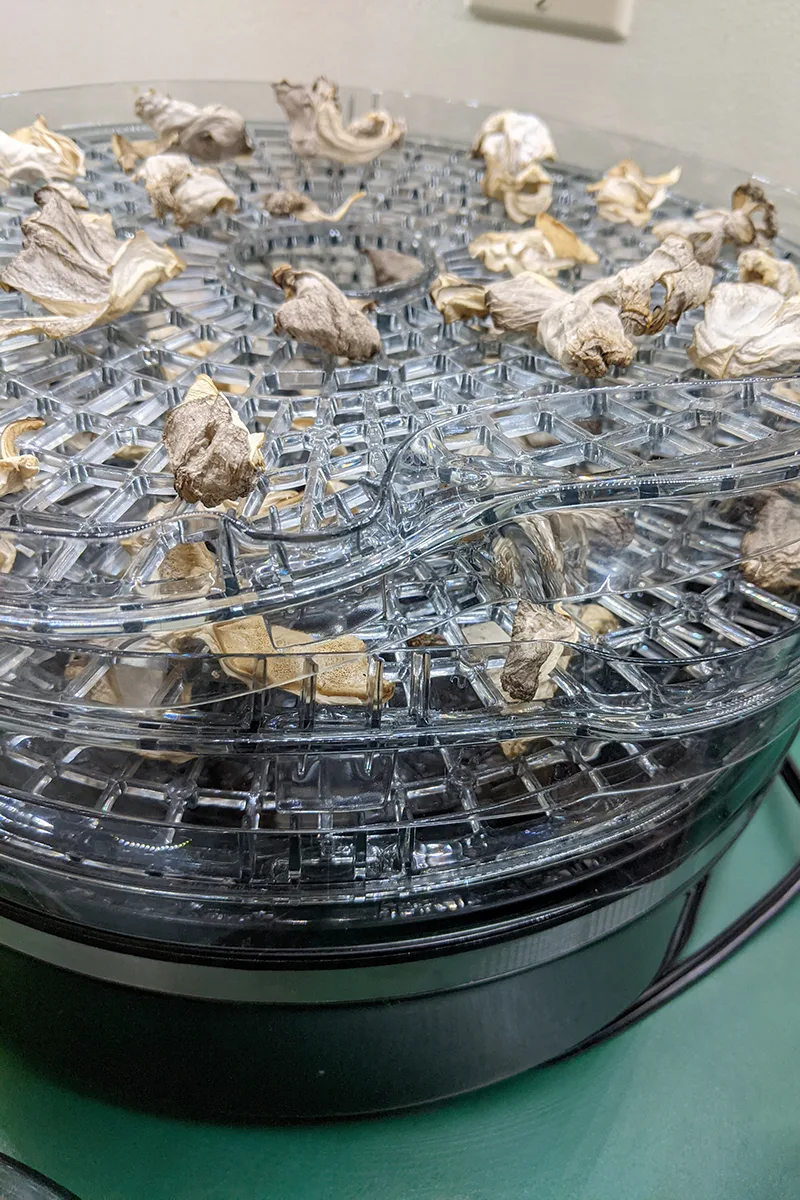
Suddenly, I realized I felt so awful because I had been breathing in the smell of slowly melting plastic all afternoon.
Lucky for me, the dehydrator was kind enough to wait until just after the return window closed before deciding to have its little meltdown.
Out of curiosity, I opened a jar of mushrooms I had dried the week before and sniffed – plastic. In the end, everything dried with this thing went in the garbage. I didn’t feel safe eating it.
I still don’t know what makes me angrier – having to replace a kitchen appliance I had for only two months or throwing away all the food impregnated with melting plastic fumes.
Why I Won’t Buy Another Stacking Countertop Model (& maybe you shouldn’t either)
I wasn’t all that impressed with this thing, to begin with. It was incredibly underpowered at 350W and took nearly three times as long as suggested in the manual for veggies to dry. I made dehydrated mirepoix with it, and it took a solid thirty hours to dehydrate celery.
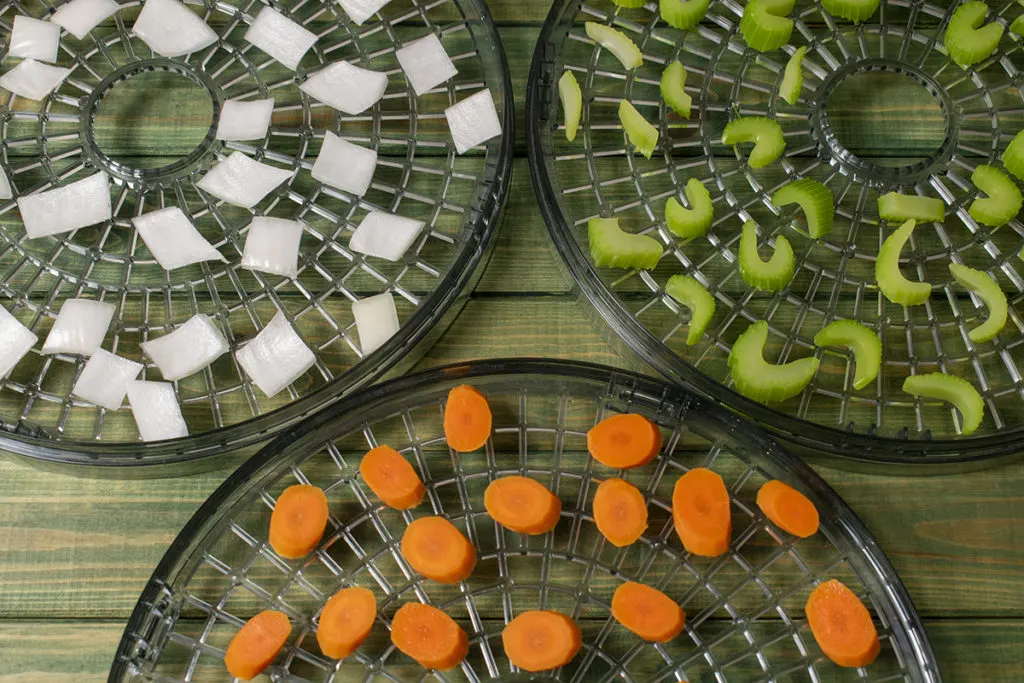
The controls allowed you to choose a temperature range rather than a specific temperature. This is quite common on these types of smaller food dehydrators.
When I tested the temperature output using an infrared thermometer, it was never the range at which it was set.
It fluctuated wildly, sometimes being ten degrees cooler or hotter than its intended temperature range – not great if you need consistent heat for things like jerky.
It came with five stacking trays, but because of the design, with the heating element and fan on the bottom, using all five trays at once meant I was constantly left with food on the top two trays that wasn’t dried. I had to shuffle the trays every hour to ensure even drying.
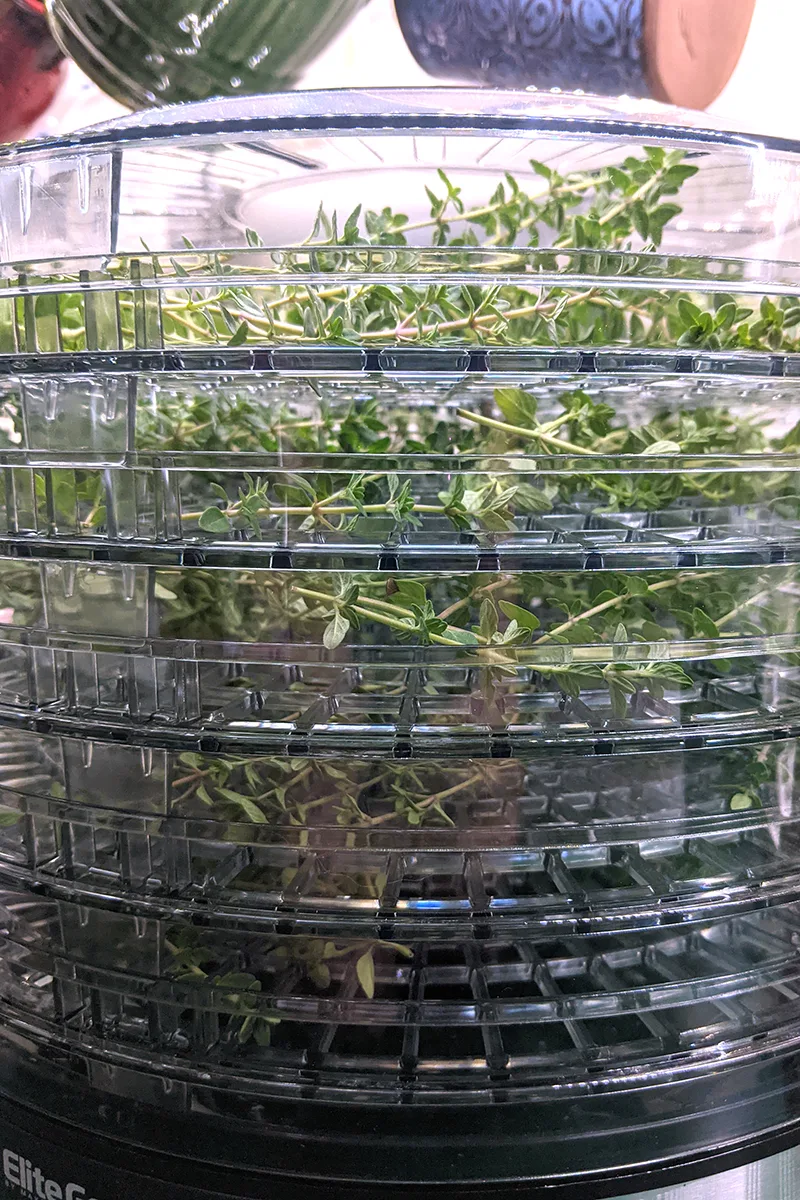
You couldn’t order more trays (you know, like, if they melted), and no other accessories were offered, so making fruit leather wasn’t an option.
The dehydrator decided to self-destruct, running on the lowest setting (95-104 degrees F), which is astonishing considering how warped the trays were. In hindsight, I’m glad I was home.
Who knows what would have happened if I had let it run all afternoon without being home.
I checked Amazon and filtered the reviews to show only one-star reviews, and sure enough, they were littered with photos of melted plastic trays and numerous grumblings of the dehydrator melting.
Unfortunately, when looking at reviews of other stacking tray models, I saw similar issues with melting trays.
I knew I needed to do my homework before making another purchase.
After a couple of months of reading Amazon reviews and articles with titles like “Top Food Dehydrators of Insert Year” and asking my electrical engineer sweetheart for electronics-purchasing advice, I knew I wasn’t going to find what I needed in a stacking tray model. I was looking for a box-style dehydrator with a fan in the back. Here are the criteria I used to choose my current food dehydrator.
What to Look for In a Food Dehydrator
Power Output
Look for 500W at the bare minimum; 600W and above is even better. I knew I wanted something with significantly more power. We would use the dehydrator quite a bit throughout the year, but mostly during the growing season. So, durability and power are a must.
Consistent Temperature
This is so important. When drying things like herbs, higher heat can cook off the volatile oils that give them their scent and flavor. Having a dehydrator that can hold a low setting is important.
Just as importantly, if you plan to dry meat or make jerky, you’ll need something that can hold a higher temperature too. Too low, and you could end up with a finished product that could make you sick.
While most manufacturers say their machines hold a consistent temperature, look for Amazon reviews where someone has tested the temperature of the model in question with an infrared thermometer or an oven thermometer.
Easy to Read and Set Controls
One of the things I wanted was a food dehydrator where I could control the temperature to the degree—no more knobs with a vague temperature range. Because, let’s face it, 95-104 degrees can mean the difference between fragrant, flavorful lemon balm and what is this unidentifiable green leaf with no flavor?
I wanted a push-button interface with a digital screen.
Air Circulation
As I mentioned, with the heating element and fan on the bottom, I constantly had to swap trays to make sure everything dried evenly. I wanted a dehydrator where the fan was in the back so it would circulate air around the trays evenly.
Tray Spacing
We grow a lot of curly kale that we dry for smoothie powder. I wanted enough space between the trays to allow good airflow without the kale being smashed by the tray above it. This meant no more fixed-height stackable trays.
Metal Trays
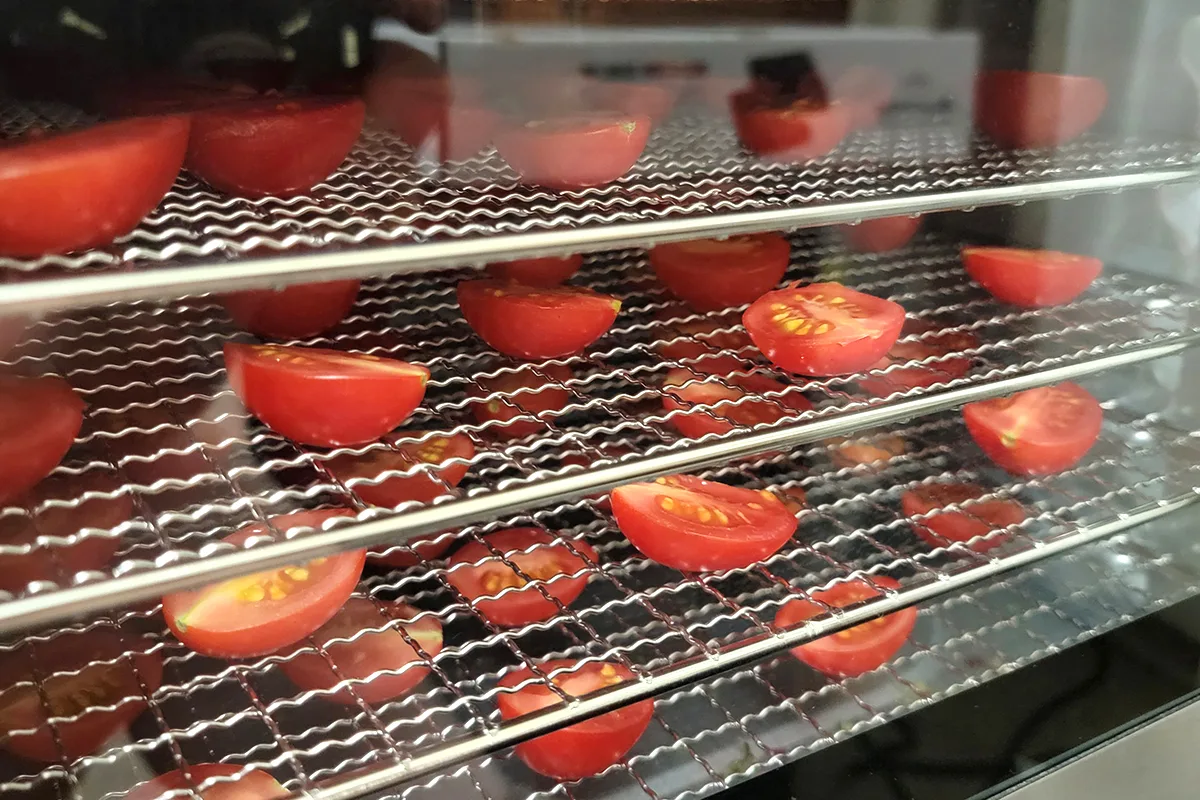
For obvious health reasons. If these suckers melt, I’ll eat my hat.
Metal Construction
I wanted a mostly metal body. A food dehydrator creates heat and runs for hours; even if it functions properly and doesn’t melt, I didn’t want to smell hot plastic in my kitchen all day. Plus, metal is more durable, and I’m clumsy.
Accessories
I wanted a model with additional trays and accessories like a fruit leather mat for purchase.
UL or ETL Listing
My sweetie insisted this was the most important thing to look for. And while I agree with him, I couldn’t find any dehydrators that weren’t UL or ETL listed.
What I Ended Up Buying
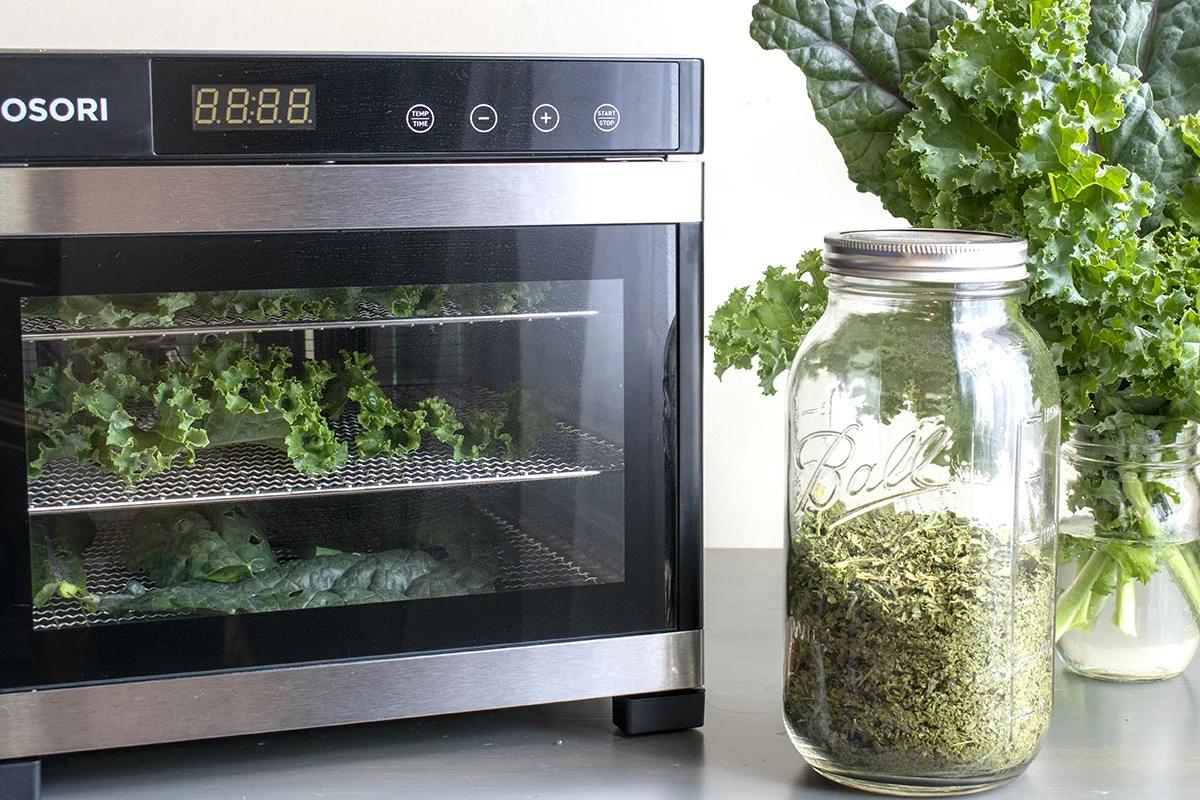
Ultimately, I decided to purchase a COSORI stainless steel six-tray food dehydrator. And I love it. It ticked all the boxes and then some. It has all the features I wanted, but what won me over was its 5-star rating with almost thirteen thousand reviews. That’s an impressive track record.
It’s on the bigger side of what I would consider being a small appliance, at 17.8 x 13.5 x 12.2 inches. But it fits easily in my pantry. And when I know I will be using it for a while, I don’t mind having it on my countertop, as it’s pretty sleek.
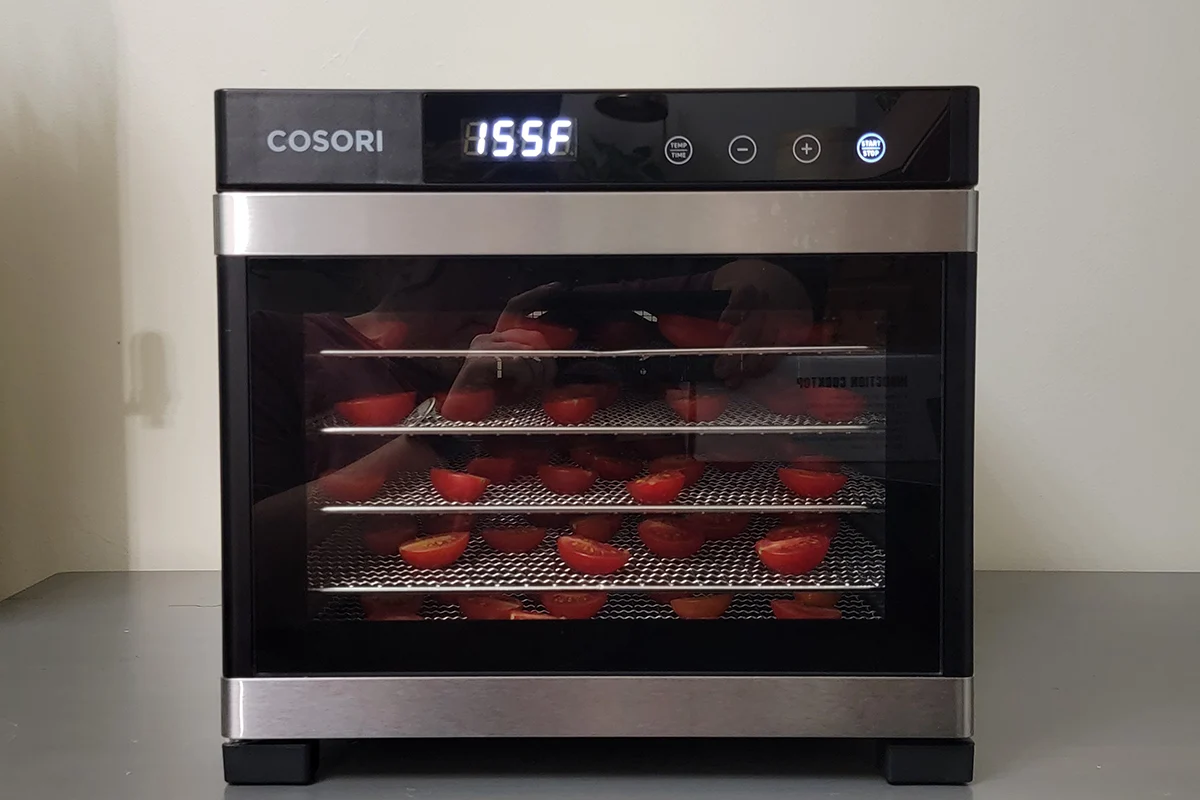
It even came with a fruit leather mat, but you can purchase more. You can even purchase silicone mats for it.
It’s a 600W machine and has an automatic shut-off. The timer can be set in thirty-minute increments for up to 48 hours, and you can set the temperature – to the degree – anywhere from 95 to 105 degrees F. And most importantly, the temperature is accurate.
I can use all six trays at once or leave a few out to create more space. The stainless-steel metal trays are easy to clean by hand or in the dishwasher, and I usually wipe out the bottom of the unit if there’s a lot of dried herbal matter or crumbs on the bottom.
It’s easy to set the temperature and the timer, and once it’s going, the fan is surprisingly quiet.
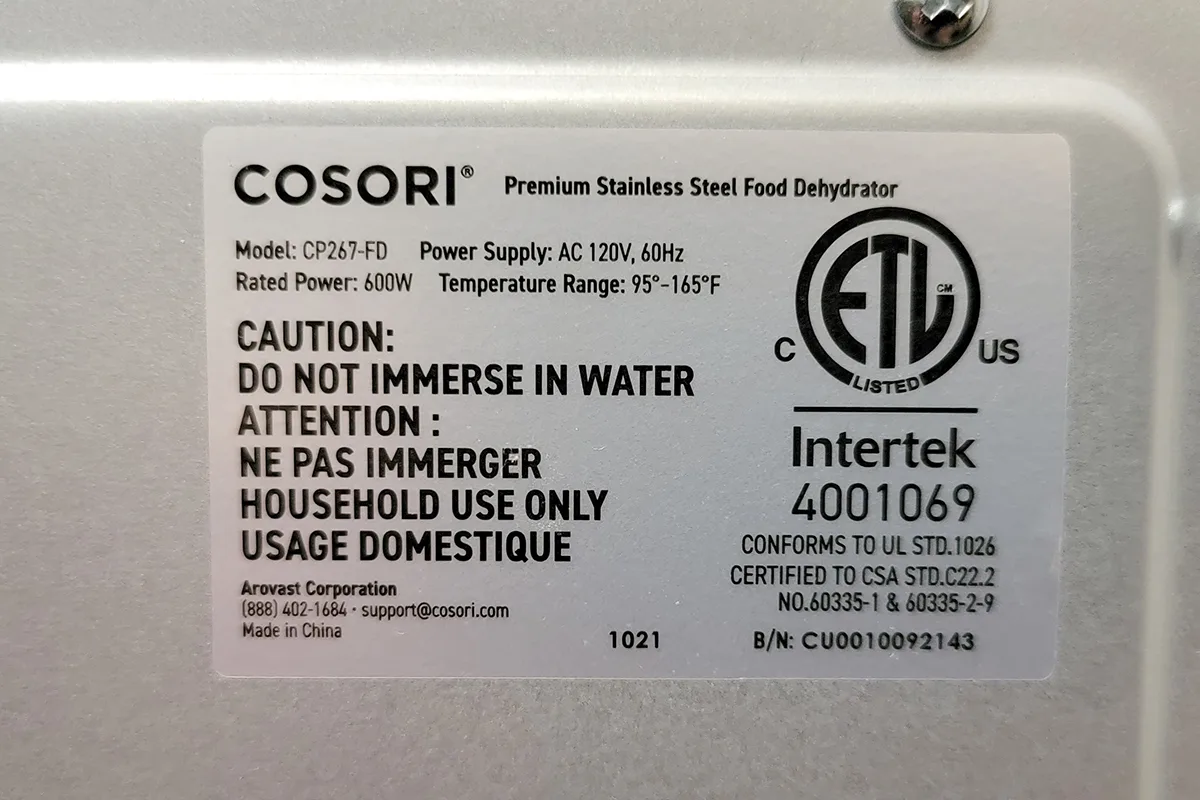
And yes, honey, it’s ETL listed.
I’ve dried lots of fruit, vegetables and herbs in it with ease. I’ve even used it to set the dye on some tie-dye t-shirts. As I write this, I’ve got a batch of “sun” dried tomatoes going, and the house smells amazing.
As we head into prime mushroom foraging season, I can rest easy knowing whatever I find, I’ll be able to keep this year. I won’t have to worry about throwing out mushrooms that taste like plastic.
I hope my cautionary kerfuffle helps you to make a more informed decision when purchasing your own food dehydrator.

Get the famous Rural Sprout newsletter delivered to your inbox.
Including Sunday ramblings from our editor, Tracey, as well as “What’s Up Wednesday” our roundup of what’s in season and new article updates and alerts.

